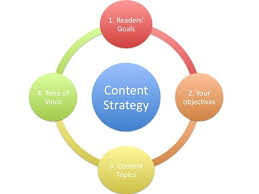In today’s hyper-competitive digital world, brands are no longer just selling products or services—they’re telling stories, building trust, and shaping experiences. And all of this begins with content. But not just any content—a structured, intentional, and results-driven content marketing strategy is what separates successful brands from the rest.
Whether you’re a startup trying to make your mark or an established business looking to scale further, creating a winning content marketing strategy can be your most powerful growth tool. This comprehensive guide will take you step-by-step through what it takes to build a strategy that not only attracts but also converts and retains your target audience in 2025 and beyond.
Why Content Marketing Strategy Is Non-Negotiable
Content is the foundation of your digital presence. Every blog post, email newsletter, video tutorial, or social media caption you put out into the world shapes the perception of your brand. However, without a coherent strategy, your content efforts become random acts of marketing—diluting your messaging, wasting your budget, and confusing your audience.
A solid content marketing strategy helps you clearly define your brand voice, identify your target audience, map the customer journey, and produce content that aligns with specific business objectives. It ensures consistency, streamlines your efforts, and allows you to measure performance meaningfully.
Step 1: Define Your Goals with Precision
Your strategy begins with defining what success looks like. Is your goal to drive website traffic, generate leads, increase brand awareness, or boost engagement? Each objective requires a tailored content approach. For instance, if your aim is to generate leads, gated content like eBooks and webinars might be your best bet.
Set SMART goals—specific, measurable, achievable, relevant, and time-bound. For example, instead of saying “We want more website traffic,” you could define it as “We aim to increase organic traffic by 40% in the next six months.” This clarity not only informs your content creation but also helps evaluate ROI later.
Step 2: Know Your Audience Better Than They Know Themselves
Great content starts with understanding who you are creating it for. Go beyond demographics and explore psychographics, pain points, behavioral traits, and buying motivations. What keeps your audience up at night? What challenges are they facing in their professional or personal lives?
Leverage customer interviews, social media analytics, website behavior data, and third-party tools to create rich buyer personas. Platforms like HubSpot, Google Analytics, and SEMrush can offer valuable insights. The more precise your audience segmentation, the more personalized and effective your content will be.
Step 3: Conduct a Content Audit to Spot Opportunities
Before you rush into creating new content, take stock of what you already have. A thorough content audit reveals what’s working, what’s underperforming, and where the gaps are.
Evaluate each piece of content based on its engagement, SEO performance, conversion rates, and relevance. Identify top-performing pieces that can be repurposed or updated for better performance. A gap analysis will show which stages of the customer journey are underserved—helping you align your content better to funnel goals.
Tools like Screaming Frog, Ahrefs, and Google Search Console can streamline the content audit process and give data-driven insights.
Step 4: Map Content to the Customer Journey
Your audience doesn’t go from stranger to buyer in one step. They move through distinct phases—awareness, consideration, and decision. Each phase requires a different type of content.
In the awareness stage, focus on educational and engaging content like blog posts, videos, and infographics to attract new visitors. During the consideration stage, offer comparisons, case studies, and testimonials to build trust. And at the decision stage, create content like demos, pricing pages, and product-focused blogs to convert prospects.
An effective content marketing strategy aligns each piece of content with a specific touchpoint on the customer journey, ensuring that users find value and relevance at every interaction.
Step 5: Choose the Right Content Types and Channels
Not all content formats are created equal. Some industries thrive on long-form blog content, while others find more engagement through short-form video or podcasts. It’s essential to know where your audience spends their time and in what formats they consume content.
Experiment with various content types—articles, whitepapers, videos, podcasts, emails, and even interactive tools—and track which formats generate the most traction. At the same time, be strategic about the distribution channels. Owned platforms like your website or email newsletter give you full control, while social and third-party platforms expand your reach.
A successful content strategy is not just about what you say but also where and how you say it.
Step 6: Develop a Content Calendar and Stick to It
Consistency is key in content marketing. A content calendar helps you plan, schedule, and publish content regularly. It also ensures a balanced mix of topics, formats, and channels.
Start with quarterly themes aligned with your business goals. Break them down into monthly content topics and weekly deliverables. Ensure your calendar includes deadlines, assigned team members, keywords, CTAs, and target personas for each piece.
Project management tools like Trello, Asana, or Notion are great for organizing your content production workflow. When your calendar is detailed and well-managed, your team stays aligned and your brand maintains a consistent presence across platforms.
Step 7: Measure, Analyze, and Refine
Your strategy is only as strong as your ability to measure it. Define the key performance indicators (KPIs) that matter most—these could include website traffic, bounce rates, time on page, lead conversions, or customer retention metrics.
Use analytics tools like Google Analytics 4, HubSpot, or SEMrush to gather data. Regularly analyze performance to identify what’s working and what needs adjustment. Look for content pieces that are outperforming, and analyze why. Also, track underperformers and explore whether the problem lies in the content, format, timing, or channel.
A strong content marketing strategy evolves. Use insights to refine your approach continuously, ensuring long-term growth and relevance.
The Role of an Online Digital Marketing Course in Strategy Mastery
If you’re looking to upskill yourself or your team in this field, enrolling in an Online Digital Marketing Course can be a game-changer. These courses not only teach you the theory behind strategy-building but also offer hands-on tools and real-world case studies that can accelerate your growth.
From understanding audience analytics and SEO fundamentals to content calendar design and distribution frameworks, a structured learning path can provide immense clarity and confidence in executing your strategy effectively.
Case Study Reference: HubSpot’s Content Marketing Flywheel
One great real-world example is HubSpot’s content marketing flywheel. Rather than focusing solely on the funnel model, they implement a circular approach—Attract, Engage, and Delight. This method ensures that every customer touchpoint builds momentum for the next, turning happy users into promoters and creating a compounding loop of growth. Their blog strategy alone generates millions of monthly visits, showcasing the power of consistent, audience-first content creation.
Another study by Content Marketing Institute (CMI, 2024) revealed that 73% of B2B marketers who had a documented content strategy reported higher success rates than those who didn’t. This reinforces the point—strategy is not optional; it’s foundational.
Final Thoughts: Strategy Is a Living Document
Creating a winning content marketing strategy isn’t about ticking boxes—it’s about understanding your audience deeply, aligning content to business goals, and evolving your approach based on data and market changes.
Treat your strategy as a living document, something that grows and adapts with your business. With a clear roadmap, consistent execution, and a willingness to refine along the way, your content efforts can become one of the most powerful drivers of long-term brand equity and revenue.
Remember, content marketing success doesn’t come from one viral video or a single well-written blog. It’s the result of thoughtful planning, persistent execution, and a relentless focus on delivering value to your audience at every step.


























